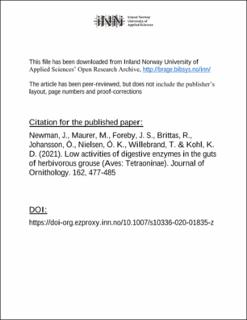Low activities of digestive enzymes in the guts of herbivorous grouse (Aves: Tetraoninae)
Newman, Julianne; Maurer, Maya; Forbey, Jennifer S.; Brittas, Rolf; Johansson, Örjan; Nielsen, Olafur K.; Willebrand, Tomas; Kohl, Kevin D.
Peer reviewed, Journal article
Accepted version

Åpne
Permanent lenke
https://hdl.handle.net/11250/2763470Utgivelsesdato
2021Metadata
Vis full innførselSamlinger
Originalversjon
Journal of Ornithology = Journal fur Ornithologie. 2021, 162, 477-485 (Published online November 2020) 10.1007/s10336-020-01835-zSammendrag
Avian herbivores face the exceptional challenge of digesting recalcitrant plant material while under the selective pressure to reduce gut mass as an adaptation for fight. One mechanism by which avian herbivores may overcome this challenge is to maintain high activities of intestinal enzymes that facilitate the digestion and absorption of nutrients. However, previous studies in herbivorous animals provide equivocal evidence as to how activities of digestive enzymes may be adapted to herbivorous diets. For example, “rate-maximizing” herbivores generally exhibit rapid digesta transit times and high activities of digestive enzymes. Conversely, “yield-maximizing” herbivores utilize long gut retention times and express lower activities of digestive enzymes. Here, we investigated the activities of digestive enzymes (maltase, sucrase, aminopeptidase-N) in the guts of herbivorous grouse (Aves: Tetraoninae) and compared them to activities measured in several other avian species. We found that several grouse species exhibit activities of enzymes that are dramatically lower than those measured in other birds. We propose that grouse may use a “yield-maximizing” strategy of digestion, which is characterized by relatively long gut retention times and generally lower enzyme activities. These low activities of intestinal digestive enzyme could have ecological and evolutionary consequences, as grouse regularly consume plants with compounds known to inhibit digestive enzymes. However, more comprehensive studies on passage rates, digestibility, and microbial contributions will be necessary to understand the full process of digestion in herbivorous birds.